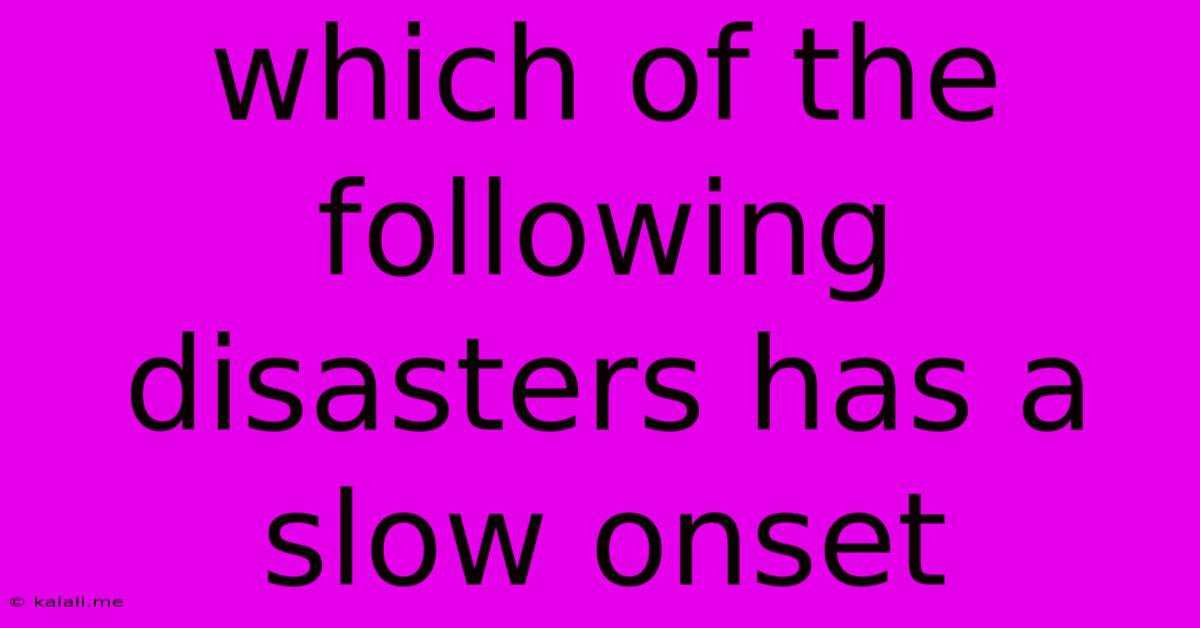Which Of The Following Disasters Has A Slow Onset
Kalali
Jun 12, 2025 · 3 min read

Table of Contents
Which of the Following Disasters Has a Slow Onset? Understanding Disaster Timeframes
Disasters can be broadly categorized by their speed of onset: sudden-onset or slow-onset. Sudden-onset disasters, like earthquakes and volcanic eruptions, strike quickly and unexpectedly, often leaving little time for preparation. Slow-onset disasters, however, unfold gradually over time, allowing for more preparedness but often leading to a prolonged period of suffering. This article will explore the difference and provide examples to help clarify which types of disasters fall into each category. Understanding these differences is crucial for effective disaster preparedness and response strategies.
Understanding Slow-Onset Disasters:
Slow-onset disasters are characterized by a gradual development, often spanning months or even years. This gradual unfolding allows for early warning systems and mitigation efforts, but the prolonged nature of the disaster can lead to chronic hardship and increased vulnerability. These events often involve complex interactions between environmental factors, social factors, and human activities.
Examples of Slow-Onset Disasters:
Several types of disasters fall under the slow-onset category. These include:
-
Droughts: A prolonged period of abnormally low rainfall, resulting in water scarcity, crop failure, and famine. The onset of a drought is often gradual, with warning signs like decreasing water levels in reservoirs and reduced rainfall becoming apparent over time.
-
Desertification: The process by which fertile land becomes desert, typically as a result of deforestation, drought, or unsustainable agricultural practices. This is a gradual process that can significantly impact livelihoods and ecosystems over decades.
-
Sea Level Rise: The gradual increase in the average sea level caused by melting glaciers and thermal expansion of water. This slow-onset disaster leads to coastal erosion, saltwater intrusion into freshwater sources, and increased vulnerability to storm surges.
-
Land Degradation: The deterioration of the land's productive capacity, often due to deforestation, overgrazing, or unsustainable farming practices. This can lead to soil erosion, reduced agricultural yields, and displacement of communities.
-
Epidemics (certain types): While some epidemics have sudden onsets, others, like those associated with malnutrition or waterborne diseases exacerbated by slow-onset disasters like drought, unfold more gradually. The conditions that breed these diseases often develop over extended periods.
-
Famine: While often triggered by a sudden-onset event like a flood or earthquake, famine itself often develops slowly as a result of factors like drought, conflict, or economic instability. It’s a slow-onset consequence of multiple factors.
Differentiating Slow-Onset from Sudden-Onset Disasters:
The key difference lies in the speed of impact. Sudden-onset disasters require immediate response, while slow-onset disasters allow for more proactive measures, albeit often over an extended duration. The response strategies for each type also differ significantly. Sudden-onset disasters necessitate immediate rescue and relief efforts, while slow-onset disasters necessitate long-term planning, adaptation strategies, and sustainable development practices.
Conclusion:
Many types of disasters, like droughts, desertification, and sea level rise, are characterized by a slow onset. Understanding this distinction is crucial for effective disaster risk reduction and management. Focusing on early warning systems, sustainable development, and community resilience is key to mitigating the impacts of these gradual but often devastating events. By recognizing the unique challenges presented by slow-onset disasters, we can build more resilient communities and minimize their devastating consequences.
Latest Posts
Latest Posts
-
How Many Seconds Are In 5 Days
Jun 13, 2025
-
What Is Half A Byte Called
Jun 13, 2025
-
Is Ifsc And Swift Code Same
Jun 13, 2025
-
Which Of The Following Is An Example Of Symmetric Encryption
Jun 13, 2025
-
Which Of The Following Statements Are True Regarding Rfid
Jun 13, 2025
Related Post
Thank you for visiting our website which covers about Which Of The Following Disasters Has A Slow Onset . We hope the information provided has been useful to you. Feel free to contact us if you have any questions or need further assistance. See you next time and don't miss to bookmark.